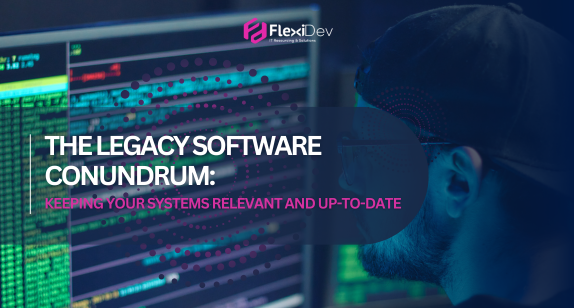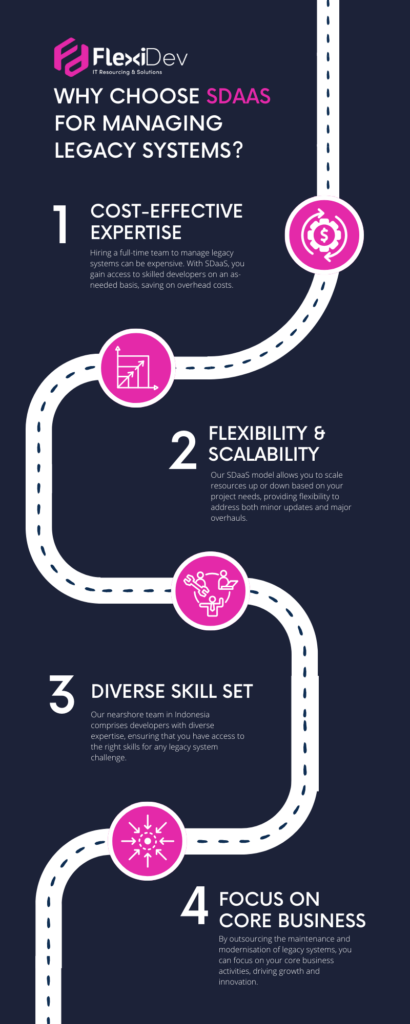
by Simon Purser – Operations Manager APAC
As a business owner, you’ve likely encountered the term “legacy software.” These are the systems that have been the backbone of your operations for years, perhaps decades. While they were cutting-edge at the time of implementation, they now pose significant challenges. Keeping these systems patched, up-to-date, and relevant is crucial to maintaining business efficiency and security. Here’s how you achieve this, and how our Software Developer as a Service (SDaaS) offering can help.
What Causes Software to Become ‘Legacy’?
Legacy software principally refers to software systems which were developed using technology which is no longer in common use. The reasons for changes to technology are typically that the industry standard has levelled up with innovations for better protection against faults and unwanted intruders, as well as for greater performance. You may be seeing the result of this in how your system communicates, or interacts, with other systems, such as through third-party integrations. While the operations of your system may not have changed, an inability to work smoothly with other technologies will have a knock-on effect on performance, and contribute to code corruption. This means that lines of code that previously worked smoothly, begin to not work as expected. It’s a part of all systems, which is why many clients engage our services to make the necessary modifications to bring their service up to speed.
On a more basic level, the flow of any software should be revamped occasionally to reflect user feedback and changes in user preferences. You may be expanding into new markets, and it is then advisable to closely tailor the user experience for each specific user type (based on what their needs and intentions are). However, even if continuing with the current system setup, you will get increased volumes over time. And this puts greater demands and strain on older systems, leading to performance issues. Hence, to maximise the effectiveness of any product it is advisable to upgrade. There are many patches and integrations which can allow a legacy system to retain high responsiveness with only a minor resource outlay, and without resorting to costly rewrites.
Security Risks and Compliance Issues
Legacy systems will often lack the robust security features found in newer software, making them vulnerable to cyber threats. An SDaaS support, as part of the service, reviews recent and impactful industry updates to advise our clients when there needs to be a modification for greater protection. This can be just a simple process, monitoring technology authority forums and keeping abreast of current malware developments. Simple to implement, and highly recommended. Assign one member of our SDaaS team to your project to keep well-informed regarding security patches that may no longer be valid, and any immediate risk of security breach.
Covering all the bases, we would also suggest updating legacy systems to keep up with regulatory requirement changes over time. If your package becomes incompatible with new compliance standards, other vendors may be unable to integrate with your product, or with a reduced service. Ensuring that old software meets current legal and industry regulations can be challenging, and we work closely with our clients’ product owners to communicate any modifications that need to be made to improve product performance. Our team can assist in updating your legacy systems to meet these requirements, avoiding legal and financial penalties.
Steps to Keep Legacy Systems Up-to-Date and Relevant
Here are some steps to ensure your investment is protected for sustained growth and product delivery:
1. Conduct Regular Audits
- Perform comprehensive audits of your legacy systems to identify vulnerabilities, inefficiencies, and areas for improvement.
- Our SDaaS team can help by providing thorough assessments and actionable insights.
2. Implement Continuous Patching
- Stay on top of security patches and updates to protect against vulnerabilities.
- Engage with our developers and DevOps team to manage and apply these patches regularly, ensuring your systems remain secure.
3. Optimise Performance
- Regularly monitor system performance and address any bottlenecks or slowdowns.
- Our expert developers can optimise your legacy systems to handle increased loads and improve efficiency.
4. Integrate with Modern Solutions
- Consider integrating legacy systems with modern software solutions to extend functionality.
- Our SDaaS team can develop custom integrations that allow your legacy systems to communicate seamlessly with newer technologies.
5. Plan for Incremental Upgrades
- Instead of a complete rewrite, plan for incremental upgrades to modernise your system over time.
- We can help you develop a roadmap for phased improvements, minimising disruption to your business service.

Why Choose SDaaS for Managing Legacy Systems? The Answer: Flexibility and Scalability
It is more practical and cost-effective to engage SDaaS to manage legacy systems. With SDaaS, you gain access to skilled developers on an as-needed basis, saving on overhead costs. FlexiDev can source expert specialists according to your technology needs from within our full-time development teams, meaning they are responsive and can better support your technology needs.. when you need the support.
Our SDaaS model allows you to scale resources up or down based on your project needs, providing flexibility to address both minor updates and major overhauls. When FlexiDev scale up, we do this with existing members from within our other teams. Hence, the current SDaaS members on your project will be able to more easily onboard these new members. They are already teammates. The extension of this is that because we source your talent from within our larger working teams, you have more choice of top talent with the appropriate experience for your technology. You have access to the right skills for any legacy system challenge.
Lastly, clients opt to outsource to us because members of our teams will have significant previous experience of similar, or the same, technology. This is an advantage as regards producing a more reliable product. What’s more, clients prefer their own teams to focus on their primary business goals, driving growth and innovation for their company. Outsourcing the maintenance and modernisation of legacy systems means you can focus on your core business.
Key Takeaways
Legacy software systems are a reality for many businesses, and it can be straightforward to upgrade them to perform on a par with the most current technology. By taking proactive steps to keep them patched, optimised, and integrated with modern solutions, you can maintain their relevance and efficiency. Engage FlexiDev SDaaS and explore the benefits of a cost-effective, flexible, and expert solution to managing your legacy systems.
Get in touch at [email protected] or [email protected] today to learn how our Software Developer as a Service can shore up and optimise your existing software, ensuring it continues to support your business needs going forward.




test reply 17/9/2024 15.18